
Medieval fortification refers to medieval military methods that cover the development of fortification construction and use in Europe, roughly from the fall of the Western Roman Empire to the Renaissance. During this millennium, fortifications changed warfare, and in turn were modified to suit new tactics, weapons and siege techniques.

A siege is a military blockade of a city, or fortress, with the intent of conquering by attrition, or a well-prepared assault. This derives from Latin: sedere, lit. 'to sit'. Siege warfare is a form of constant, low-intensity conflict characterized by one party holding a strong, static, defensive position. Consequently, an opportunity for negotiation between combatants is common, as proximity and fluctuating advantage can encourage diplomacy. The art of conducting and resisting sieges is called siege warfare, siegecraft, or poliorcetics.

A defensive wall is a fortification usually used to protect a city, town or other settlement from potential aggressors. The walls can range from simple palisades or earthworks to extensive military fortifications with towers, bastions and gates for access to the city. From ancient to modern times, they were used to enclose settlements. Generally, these are referred to as city walls or town walls, although there were also walls, such as the Great Wall of China, Walls of Benin, Hadrian's Wall, Anastasian Wall, and the Atlantic Wall, which extended far beyond the borders of a city and were used to enclose regions or mark territorial boundaries. In mountainous terrain, defensive walls such as letzis were used in combination with castles to seal valleys from potential attack. Beyond their defensive utility, many walls also had important symbolic functions – representing the status and independence of the communities they embraced.
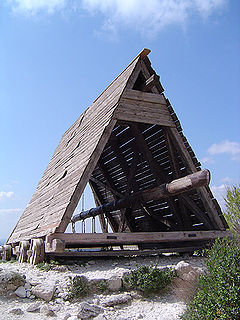
A siege engine is a device that is designed to break or circumvent heavy castle doors, thick city walls and other fortifications in siege warfare. Some are immobile, constructed in place to attack enemy fortifications from a distance, while others have wheels to enable advancing up to the enemy fortification. There are many distinct types, such as siege towers that allow foot soldiers to scale walls and attack the defenders, battering rams that damage walls or gates, and large ranged weapons that attack from a distance by launching projectiles. Some complex siege engines were combinations of these types.

Publius Cornelius Scipio Africanus Aemilianus, known as Scipio Aemilianus or Scipio Africanus the Younger, was a Roman general and statesman noted for his military exploits in the Third Punic War against Carthage and during the Numantine War in Spain. He oversaw the final defeat and destruction of the city of Carthage. He was a prominent patron of writers and philosophers, the most famous of whom was the Greek historian Polybius. In politics, he opposed the populist reform program of his murdered brother-in-law, Tiberius Gracchus.
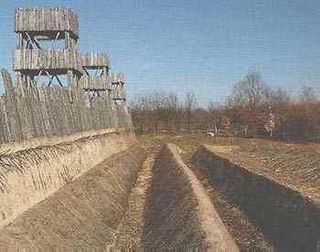
The Battle of Alesia or Siege of Alesia was a military engagement in the Gallic Wars around the Gallic oppidum of Alesia in modern France, a major centre of the Mandubii tribe. It was fought by the Roman army of Julius Caesar against a confederation of Gallic tribes united under the leadership of Vercingetorix of the Arverni. It was the last major engagement between Gauls and Romans, and is considered one of Caesar's greatest military achievements and a classic example of siege warfare and investment; the Roman army built dual lines of fortifications – an inner wall to keep the besieged Gauls in, and an outer wall to keep the Gallic relief force out. The Battle of Alesia marked the end of Gallic independence in the modern day territory of France and Belgium.
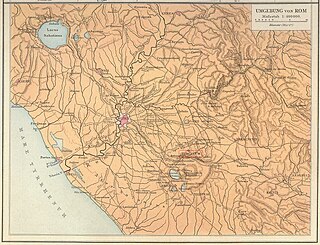
The Battle of Mount Algidus was fought in 458 BC, between the Roman Republic and the Aequi, near Mount Algidus in Latium. The Roman dictator Lucius Quinctius Cincinnatus turned an expected Roman defeat into an important victory.
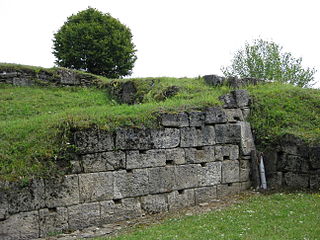
Murus Dacicus is a construction method for defensive walls and fortifications developed in ancient Dacia sometime before the Roman conquest. It is a mix between traditional construction methods particular to Dacian builders and methods imported from Greek and Roman architecture and masonry, and – although somewhat similar construction techniques were used before, during and long after the period – it has peculiarities that make it unique.

Trajan's Wall is the name used for several linear earthen fortifications (valla) found across Eastern Europe, in Moldova, Romania, and Ukraine. Contrary to the name and popular belief, the ramparts were not built by Romans during Trajan's reign, but during other imperial periods. Furthermore, the association with the Roman Emperor may be a recent scholarly invention, only entering the imagination of the locals with the national awakening of the 19th century. Medieval Moldavian documents referred to the earthworks as Troian, likely in reference to a mythological hero in the Romanian and Slavic folklore. The other major earthen fortification in Romania, Brazda lui Novac, is also named after a mythological hero.

The Celtiberian oppidum of Numantia was attacked more than once by Roman forces, but the Siege of Numantia refers to the culminating and pacifying action of the long-running Numantine War between the forces of the Roman Republic and those of the native population of Hispania Citerior. The Numantine War was the third of the Celtiberian Wars and it broke out in 143 BC. A decade later, in 133 BC, the Roman general and hero of the Third Punic War, Scipio Aemilianus Africanus, subjugated Numantia, the chief Celtiberian city.

Investment is the military process of surrounding an enemy fort with armed forces to prevent entry or escape. It serves both to cut communications with the outside world and to prevent supplies and reinforcements from being introduced.
The First Siege of Rome during the Gothic War lasted for a year and nine days, from 2 March 537 to 12 March 538. The city was besieged by the Ostrogothic army under their king Vitiges; the defending East Romans were commanded by Belisarius, one of the most famous and successful Roman generals. The siege was the first major encounter between the forces of the two opponents, and played a decisive role in the subsequent development of the war.

The Battle of Utica was fought in 203 BC between armies of Rome and Carthage during the Second Punic War. Through a surprise attack, the Roman commander Scipio Africanus managed to destroy a numerous force of Carthaginians and their Numidian allies not far from the outflow of the Medjerda River in modern Tunisia. Thus he gained a decisive strategic advantage, switched the focus of the war from Italy and Iberia to Carthaginian north Africa, and contributed largely to the final Roman victory.

The Vallum is a huge earthwork associated with Hadrian's Wall in England. Unique on any Roman frontier, it runs practically from coast to coast to the south of the wall.

The siege of Grol in 1627 was a battle between the Army of the Dutch Republic, commanded by Frederick Henry, Prince of Orange, and the Spanish-controlled fortified city of Grol, during the Eighty Years War and the Anglo–Spanish War in 1627. The Spanish Army, led by Hendrik van den Bergh, came to relieve Grol but too late. The siege lasted from 20 July until 19 August 1627, resulting in the surrender of the city to the Dutch army.

The Moesian Limes is the modern term given to a collection of Roman fortifications between the Black Sea shore and Pannonia, present-day Hungary, consisting primarily of forts along the Danube to protect the Roman provinces of Upper and Lower Moesia south of the river.
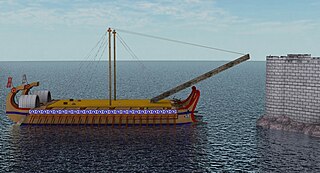
The sambuca was a ship-borne siege engine which was invented by Heracleides of Tarentum and was first used unsuccessfully by Marcus Claudius Marcellus during the Roman siege of Syracuse in 213 BC.

The Cité de Carcassonne is a medieval citadel located in the French city of Carcassonne, in the Aude department, Occitanie region. It is situated on a hill on the right bank of the River Aude, in the southeast part of the city proper. The citadel was restored at the end of the 19th century and in 1997 it was added to the UNESCO list of World Heritage Sites because of its exceptional testimony to the architecture and planning of a medieval fortress town.

A palanka, also known as parkan in Southern Hungary and palanga, was a wooden fortification used by the Ottoman Empire extensively in certain regions of Southeast Europe, including Hungary, the Balkans and the Black Sea coast against rival states, especially the Archduchy of Austria and the Kingdom of Hungary. Such wooden forts could be built and expanded quickly, and usually contained a small garrison. These fortifications varied in size and shape but were primarily constructed of palisades. Palankas could be adjacent to a town and later they could be replaced by a more formidable stone fortress as in the case of Uyvar. Palankas could also be built as an extension of the main fortress. Many Ottoman forts were a mixture of palanka type fortifications and stonework. Evliya Çelebi describes the word palanka also as a technique of timber masonry.
Siegecraft originated in Ancient Greece. This type of siege originated from the moment in which the stage of the mere siege was surpassed by an exceptional development of military techniques, which were hardly taken any further during the Middle Ages, until the invention of firearms. The importance of siege techniques was due to the increase in the strategic role of the city to the detriment of the territory in the overall defense of the polis.



















